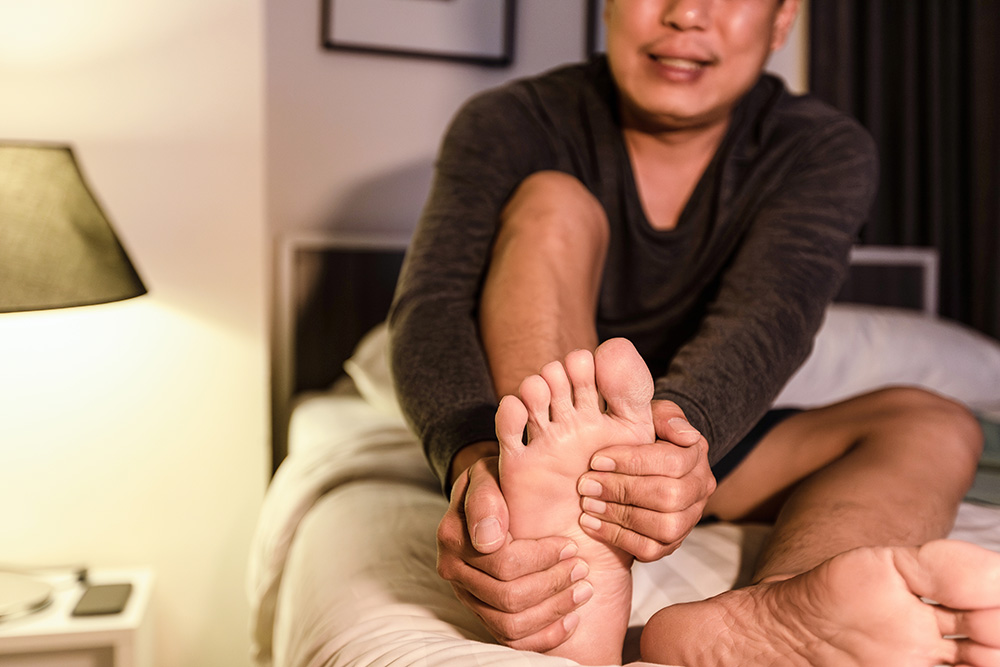Living with pain, cramps, or achiness in your lower limbs can be frustrating and confusing. Both peripheral arterial disease (PAD) and neuropathy can cause these symptoms, and they share some common risk factors, like a previous diagnosis of diabetes. However, they affect different systems in your body.
To find relief and get the proper treatment, it’s essential to understand the differences between PAD vs neuropathy.

Your peripheral nervous system (PNS) includes the nerves that extend from your brain and spinal cord to the rest of your body. These nerves are responsible for movement and sensation. When one or more of these nerves become damaged, their ability to send signals to each other is impacted. This is known as peripheral neuropathy, which can cause symptoms like:
These symptoms are most common in the legs and feet.
It can sometimes be challenging to determine what caused nerve damage to develop. This is known as idiopathic neuropathy.
Known risk factors include:
Like neuropathy, peripheral artery disease (PAD) can cause painful symptoms in your legs and feet, such as:
While symptoms are similar, there are key differences between vascular pain vs neuropathic pain.
So, the question remains: can PAD cause neuropathy? PAD (and its resulting symptoms) can lead to nerve damage, especially if you have diabetes. If PAD reduces blood flow to your legs, the nerves may not get enough oxygen, potentially leading to arterial neuropathy.
Treating PAD can help reduce this risk.
While it can be difficult to distinguish between PAD vs peripheral neuropathy, an accurate neuropathy or peripheral artery disease diagnosis is essential for effective treatment.
The specialists at Georgia Endovascular use a noninvasive test called the Ankle-Brachial Index (ABI). This quick test is performed on an outpatient basis in their Atlanta office.
If your ABI score confirms PAD, further testing may be required to determine the extent of disease progression, along with appropriate interventions. Fortunately, there are many effective, minimally invasive PAD treatments available, including:
However, if diagnostic testing reveals nerve pain vs vascular pain—depending on the underlying causes of neuropathy—you may have success treating your symptoms with over the counter (OTC) or prescription pain medications.
Treatments for neuropathy include:
While treatments for PAD and neuropathy can relieve discomfort and prevent further damage, they cannot reverse existing damage. That’s why focusing on prevention is crucial, especially if you have one or more risk factors for PAD neuropathy.
It may be possible to prevent PAD, neuropathy, and other conditions by controlling underlying conditions such as diabetes. To lower your risk, consider the following:
If you do develop peripheral artery disease vs peripheral neuropathy, addressing the issues early is crucial to easing your discomfort and preventing further damage.
The first step is getting an accurate diagnosis. Once you have that, it’s important to seek prompt treatment. If your lower leg or foot pain is linked to PAD, consider requesting a consultation with the interventional radiologists at Georgia Endovascular. They can help you explore effective treatments and create a personalized care plan to improve your quality of life.

Atlanta
3225 Cumberland Blvd. Southeast, Suite 520
Atlanta, GA 30339
Stockbridge
1035 Southcrest Dr., Suite 220 + 250
Stockbridge, GA 30281
Tucker
1975 Lakeside Pkwy., Suite 300
Tucker, GA 30084
Scheduling
Please contact our dedicated specialists to schedule a consultation today.
2025 Georgia Endovascular. All rights reserved. Website Design by Healthcare Success